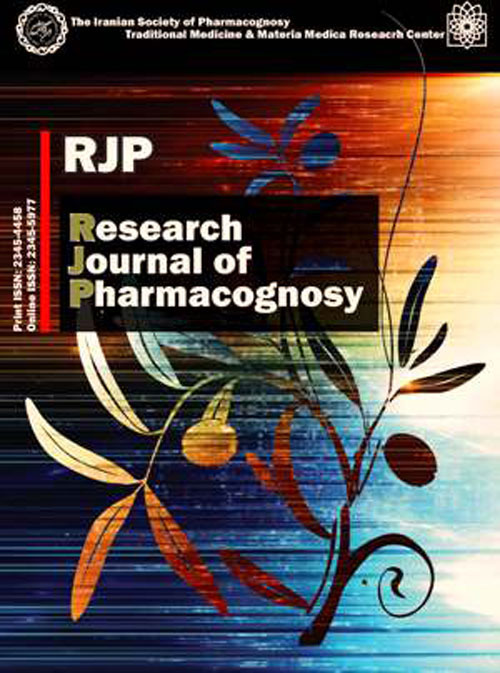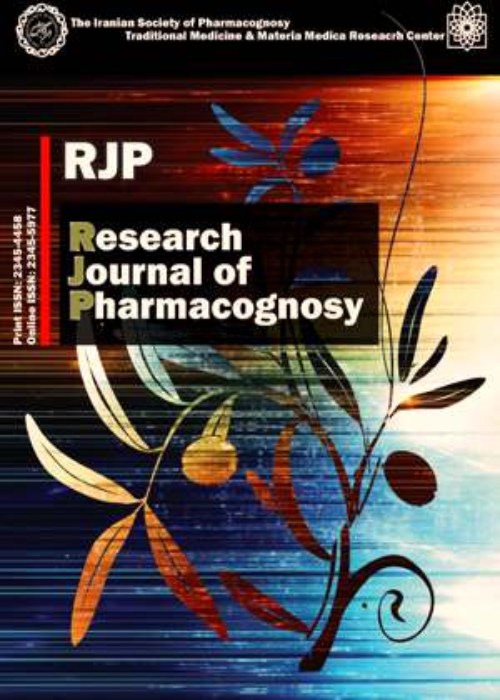فهرست مطالب

Research Journal of Pharmacognosy
Volume:9 Issue: 2, Spring 2022
- تاریخ انتشار: 1401/01/14
- تعداد عناوین: 8
-
-
Pages 1-7Background and Objectives
Novel drug delivery systems improve bioavailability of standardized plant extracts which enables them to cross the biological membranes. Biodegradable polymeric nanoparticle systems are an approach to circumvent problems in drug delivery. Tribulus terrestris growing in subtropical areas has exhibited some biological and pharmacological activities; it contains compounds like flavonoids and steroids. To improve bioavailability of active compounds of the plant, its extract was subjected to prepare nanoparticles.
MethodsAqueous ethanol 80% extract of the whole plant was used for preparation of encapsulated nanoparticles using poly DL-lactic-co-glycolic acid (PLGA) polymer. Mean particle size, polydispersity, drug loading and encapsulation efficiency of the nanoparticles systems were evaluated in various ratios of T. terrestris extract.
ResultsAll the applied concentrations of the extract provided particles in nano-scale size (163-214 nm). By increasing the extract ratio encapsulation efficacy also increased ranging between 40.3-78.5%. Above 50% of the loaded extract released in the first 3 h and it continued for 10 days.
Conclusionthe plant extract has been successfully encapsulated into PLGA polymer. The quantification of encapsulation efficiency and in vitro release also showed that application of the plant in pharmaceutical field can be improved using nanoparticles.
Keywords: nano delivery system, Nanoparticle, plant extract, Polymers, Tribulus terrestris -
Pages 9-17Background and objectives
Nowadays, the use of medicinal plants is on the rise mainly due to the fewer side effects and lower costs. Despite the traditional reports about the healing properties of Ajuga species, no clinical studies have been conducted. In this study, the effect of hydroalcoholic extract cream (3%) of Ajuga chamaecistus ssp. tomentella, one of the exclusive species of Ajuga in Iran, was compared with nitrofurazone cream (0.2%) on the second-degree burn wound healing.
MethodsThis clinical trial was performed at Motahhari Burns Hospital in Tehran. Fifty-two cases of second-degree burn patients were randomly assigned to two groups of 26 members, including nitrofurazone and Ajuga. We evaluated the wounds based on the onset of epithelialization, healing time, post-drug irritation, primary irritation, decreased irritation, post-drug pain, primary pain, decreased pain, allergy, infection parameters, and the Bates-Jensen Wound Assessment Tool.
ResultsAjuga cream was more effective than nitrofurazone in terms of the mean day of epithelialization onset (p = 0.007), healing time (p = 0.001), post-drug irritation (p = 0.007), decreased irritation (p <0.001), post-drug pain (p = 0.018) and decreased pain (p = 0.001).
ConclusionAccording to the results, the Ajuga cream (3%) can be a useful remedy for burn wounds due to the reduction in the onset of epithelialization, healing time, post-drug irritation, irritation reduction, post-drug pain, and pain reduction. However, further large clinical trials are needed to confirm these results.
Keywords: Ajuga, nitrofurazone, second degree burns, wound healing -
Pages 19-27Background and objectives
Trametes species have been used for centuries in traditional medicine of Asian countries. Recently, some of the bioactive compound have been isolated and evaluated for therapeutic purposes from these species. The aim of this study was to report the isolation and structure elucidation of major sterols from fruiting bodies of Trametes gibbosa. Volatile compounds and antioxidant activities of the different mushroom extracts of mushroom were also examined.
MethodsThe fruiting bodies of T. gibbosa were extracted with n-hexane, methanol, and hot water, respectively. For isolation of sterols, the n-hexane extract was subjected to column chromatography and fractionated by step gradient of n-hexane: ethyl acetate. The volatile oil was prepared by hydrodistillation and analyzed by GC-MS. For evaluation of the antioxidant activity, 2,2-diphenyl-1-picrylhydrazyl and ferric reducing antioxidant power assays were used. Moreover, the phenolic and carbohydrate contents were assessed using spectrophotometry methods.
ResultsThe column chromatography of the n-hexane extract led to the isolation of three sterols. These compounds were identified for the first time in T. gibbosa as follows: ergosta-5,7,22-trien-3β-ol (ergosterol); 5,8-epidioxy-ergosta-6,22-dien-3-ol; 5,9-epidioxy-8,14-epoxy-ergosta-6,22-dien-3-ol. The most abundant volatile compounds were identified as aldehydes (29.01%), fatty acids (21.2%) and alcohols (12.07%). Based on antioxidant results, methanol and hot water extracts showed the highest activities in DPPH (EC50=588.56±36.37 µg/mL) and FRAP (432±6.6 mmol Fe2+/g DW) methods, respectively.
ConclusionTrametes gibbosa is a valuable source of mycochemicals such as sterols, carbohydrate and phenolics. Further investigations are required for evaluation of the therapeutic potentials of the isolated compounds.
Keywords: Antioxidant, ergosterol, ergosterol peroxide, Trametes gibbosa -
Pages 29-36Background and objectives
Boswellia serrata is an important medicinal plant with strong antioxidant activity. The present study was designed to evaluate the effects of Boswellia vaginal gel on apoptosis and oxidative damage in vaginal mucosal cells of women with vaginal candidiasis.
MethodsNinety-five women with vaginal candidiasis were enrolled in the clinical trial and received the gel for seven consecutive nights. The clinical symptoms of the disease including vaginal secretion, pain, itching, unpleasant odor, and dyspareunia were recorded. Vaginal discharges were collected before and after treatment for the assessment of malondialdehyde (MDA) and total antioxidant capacity (TAC) using TBAR and FRAP methods, respectively. Expression of Bax, Bcl2, and Caspases-3 genes was surveyed by RT-PCR.
ResultsGel therapy significantly decreased the frequency of pain, burning, itching, dyspareunia and secretion compared to the baseline (p<0.001). Boswellia vaginal gel treatment significantly improved TAC values (from 1.27 ± 0.41 μM/mL to 4.69 ± 0.53 μM/mL; p<0.001) and decreased MDA values (from 31.47 ± 6.69 nM/L to 13.85 ± 3.72 nM/L; p<0.001). The therapy caused a significant decrease in Bax and Casp3 expression, as well as Bax/Bcl2 ratio by 2.34-fold (p=0.018), 2.86-fold (p=0.002), and 12.72-fold (p<0.001), respectively. In contrast, BVG treatment significantly enhanced the expression of Bcl2 expression by 5.42- fold (p<0.001).
ConclusionVaginal candidiasis is remarkably linked to oxidative stress, reduction of the antioxidants and vaginal mucosal cells apoptosis. Boswellia vaginal gel has potential role to improve vaginitis symptoms by elevating antioxidants capacity, mitigating oxidative stress, as well as down-regulating of apoptotic factors.
Keywords: Antioxidant, Apoptosis, Boswellia, oxidative stress, vaginal candidiasis -
Pages 37-44Background and objectives
Medicinal plants have been considered as important sources of potent free radical scavengers as well as digestive enzymes inhibitors. Several plants are used in traditional and modern medicine for their biological properties such as anti-oxidant and anti-diabetic activity. The aim of this study was to investigate the anti-diabetic and anti-oxidant activities of roots and aerial parts from three of five native Iranian herbaceaous Geum species, including G. iranicum, G. kokanicum and G. urbanum. The Geum species and their bio-active substances are getting a lot of attention due to their various biological effects, such as anti-oxidant, anti-diabetic, anti-tumor and anti-microbial activities.
MethodsThe anti-diabetic activity of the Geum species was evaluated via α-glucosidase and α-amylase inhibition assays. The anti-oxidant effect was analyzed using the free radical scavenging method and the total phenolics content was determined via a colorimetric assay.
ResultsBased on our study, all the examined species revealed moderate to high anti-diabetic and anti-oxidant effects. Geum kokanicum roots showed the highest α-glucosidase inhibition activity (91.0%±1.7) at the concentration of 500 µg/mL and DPPH radical scavenging potential (IC50: 11.6±0.5 μg/mL).
ConclusionThe results demonstrated in-vitro anti-diabetic property of G. kokanicum, so detailed investigation to isolate the active compounds is suggested.
Keywords: α-glucosidase, α- amylase, Antioxidant, Geum, phenolic content -
Pages 45-51Background and objectives
More than half of the cervicitis cases are non-gonococcal and non-chlamydial. Therefore, the cure rate of the principal treatment protocol has reduced to less than 50%. Complementary therapy is an option for adjuvant therapy when standard medical treatment is not effective enough. Honey is used as a natural agent for wound healing and antibacterial effect. This study aimed to compare the effect of honey adjuvant therapy with the standard antibiotic therapy in improving the cure rate of cervicitis.
MethodsIn this double-blind randomized clinical trial, we enrolled 102 women diagnosed with cervicitis with standard criteria who referred to the gynecological clinic of Mousavi Hospital, Zanjan, Iran. They were randomly divided into two groups. The control group received the oral standard antibiotic treatment plus lubricant gel as placebo, and the intervention group received the oral standard treatment plus vaginal Ziziphus honey as adjuvant therapy. Both groups received the treatment once a day for two weeks. The symptoms and clinical findings of the patients were evaluated for three weeks following the initiation of the treatments.
ResultsAll clinical symptoms of cervicitis significantly decreased after the treatment in both groups (p≤0.05), but the vaginal discharge of the intervention group reduced more (p≤0.05). In addition, the intervention group showed better results for the restoration of cervical erosion in comparison with the control group (p<0.05).
ConclusionVaginal honey adjuvant therapy can improve the efficiency of standard antibiotic treatment to reduce the clinical symptoms of cervicitis.
Keywords: cervical erosion, cervicitis, Complementary Therapies, honey, vaginal discharge -
Pages 53-61Background and objectives
Trimethyltin chloride (TMT) is a chemical with neurotoxic effects on central nervous system. Carvacrol is a phenolic monoterpenoid with antioxidative properties derived from oregano, thyme, and other plants. We aimed to explore carvacrol effects on TMT-induced oxidative damage focusing on nuclear factor erythroid 2-related factor 2 (Nrf2)/ kelch-like ECH associated protein 1 (Keap1)/antioxidant response element (ARE) pathway and Sirt1.
MethodsThirty- two male rats were divided into four equal groups. Groups 1 and 2 received normal saline (control) and Dimethyl sulfoxide (DMSO, sham) for 21 days, respectively. Groups 3 and 4 were first treated with TMT (8 mg/kg) and then received normal saline and carvacrol (40 mg/kg) for 21 days, respectively. Finally, the levels of malondialdehyde (MDA), total antioxidant capacity (TAC), and total oxidant status (TOS) in serums and expressions of Nrf2, heme oxygenase-1 (Ho-1), Keap1, NADPH quinone oxidoreductase (NQO-1) and Sirtuin1 (Sirt1) in the hippocampus of the rats were quantified.
ResultsTMT significantly decreased Nrf2, HO1, NQO1, Sirt1 expressions and TAC level, while markedly increased expression of Keap-1 and levels MDA and TOS compared with control groups. Carvacrol treatment significantly upregulated Nrf2, HO1, NQO1, and Sirt1 along with an increase in TAC level as compared with TMT-treated rats. On the other hand, carvacrol caused a significant decrease in the expression of Keap-1 and levels of MDA and TOS compared with controls.
ConclusionOur results suggested the potential neuroprotective effects of carvacrol on TMT-triggered neurotoxicity probably by reciprocal regulation of Keap1/Nrf2/ARE pathway and Sirt1 activity.
Keywords: carvacrol, Keap1, Nrf2, sirt1, Trimethyltin Chloride -
Effect of Different Extracts of Ganoderma lucidum on Ochratoxin A Formation by Aspergillus ochraceusPages 63-70Background and objectives
Mycotoxins are secondary metabolites produced by fungi contaminated agricultural products and have toxic effect in human and animals. Ochratoxin A is produced by many filamentous fungi species such as Aspergillus and Penicillium, and is classified as a possible carcinogen and nephrotoxic. Ganoderma lucidum is a famous mushroom with antifungal properties and probably preventive effect on toxin production. The aim of this study was to investigate the antitoxigenic properties of Iranian strain of G. lucidum as a natural antitoxigenic agent against harmful filamentous fungi in food industry.
MethodsDifferent extracts of G. lucidum were prepared and the antifungal and antitoxigenic effects were studied on toxigenic Aspergillus ochraceus. Ethanolic, hydroalcoholic and aqueous extracts were prepared by cold maceration method and compared with commercial extracts. Ochratoxin A was analyzed by high performance liquid chromatography (HPLC) coupled with fluorescence detector in A. ochraceus culture media which was treated with the extracts.
ResultsThe results expressed that the alcoholic extracts could inhibit fungal growth but the aqueous extracts were able to significantly prevent toxin production while the fungus totally grew.
ConclusionGanoderma lucidum and its products, may be used as a pharmaceutical and nutraceutical mushroom and could be considered as safe and useful agents for prevention of fungal growth and mycotoxin formation in food and agricultural products.
Keywords: Aspergillus ochraceus, Ganoderma lucidum, HPLC, Mycotoxins, ochratoxins


